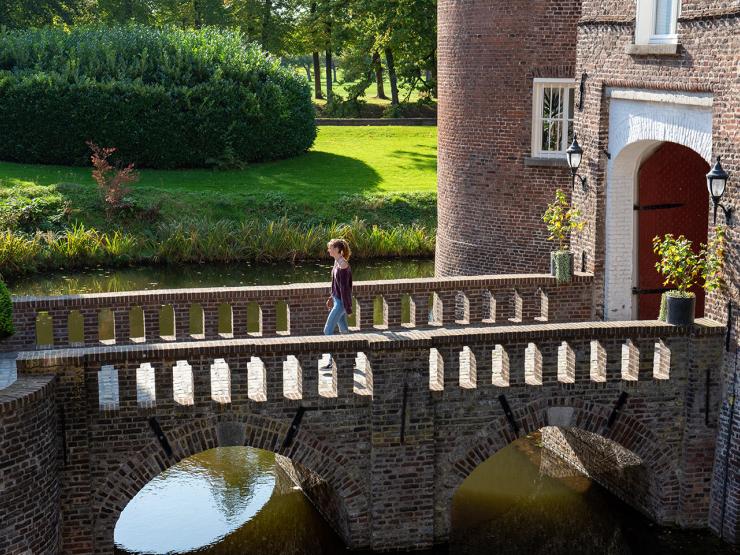The Village Of Well
The village of Well is a small town of about 2,500 residents. It is located in the southernmost province of the Netherlands and has its own distinctive character. The area is very rural, and filled with numerous walking and cycling paths. There are pastures with horses, goats, pigs, alpacas, and sheep and beautiful landscapes. There is an “old” section and a “new” section of Well, with the castle in the middle. Well is located midway between the Dutch cities of Nijmegen and Venlo, close to the border of Germany.
A Brief History of Kasteel Well
The castle is a Dutch National Monument and there are early drawings of the castle in the Rijksmuseum in Amsterdam. The “sweet-water” well, for which the town was named, established Well as a landmark for knights on their personal quests. In 975 A.D., the townspeople built a watchtower near this well. In 1275 A.D., Duke Geldern traveled from Germany and began to build a castle around the watchtower. He enclosed the well within the walls of the courtyard, dug moats and designed the construction of the castle. Inspired by the Crusades, the Duke envisioned the castle as a place of sanctuary, a place of inspiration, and a place of vision.
Since 1275 over 10 regal families have lived in the castle. Though much of the medieval structure remains, most of what the castle looks like today dates from the 17th century, when the Duke of Limburg repaired and expanded the old castle. Baron Frans Peter von Schloissnig initially restored the castle to a state of prosperity, but a series of prolonged hardships over three generations forced the family to sell the castle in 1905.
Dr. Richard Wolters, from Dusseldorf, purchased the castle in 1905 and lived there with his wife until 1939, when she died.
During WWII, Dr. Wolters fled back to Germany because of local resentment toward Germans. When Dr. Wolters abandoned the castle, the German Army took it over and used it initially as a command headquarters. Nazi officers lived here early in the occupation, and later in the war the castle became an observation point in anticipation of an Allied invasion. Before the liberation, the castle became a hospital for German soldiers and, reportedly, Allied bomber crews were imprisoned there until they could be taken to P.O.W. camps.
After the war, the castle became a refuge and temporary shelter for thousands of people who returned to the village of Well without a place to live. The mayor of Well stayed there after the war, where he ran the local government until more permanent buildings could be reconstructed. The Limburg Castle Society took over the Castle after the war and rented it out to many different schools who used it as a place of learning. Emerson College purchased it in 1988.
Fun Facts
- The Netherlands, is twice the size of the state of New Jersey.
- The Dutch are considered to be disciplined, thrifty, egalitarian, direct in their speech, hardworking, practical and well organized. They place a high value on cleanliness and neatness.
- Population: ~18 million. Government: Constitutional monarchy
- Potatoes and Cheese are main ingredients in most Dutch meals.
- There are over 23 million bicycles in use, more than one per citizen. Everywhere you will find bicycle lanes next to the road and cyclists even have their own traffic lights.
- About a quarter of the country's area is below sea level.
- The Netherlands has two capitals: Amsterdam (the official capital by constitution) and The Hague (the seat of government and first capital since 1584).
- Dutch students learn English, French, and German in high school.
- Dutch is also spoken in Belgium, northern France, Suriname, Antilles and Aruba. In South Africa, the Afrikaner language is very closely related to Dutch.
- There are over 1,200 windmills in the Netherlands.
- The Netherlands was the first country in the world to legalize same-sex marriage.
- Orange is the official color of the Netherlands in honor of the House of Orange, who led the Dutch Revolt against Spain.
- The 'Netherlands' means "low country" in Dutch.
- Dutch people are the tallest in the world, with an average height of 6 feet for men and 5' 7" for women.
Learn Some Dutch
Most Dutch citizens speak some English. However, it will be greatly appreciated and respectful toward your hosts if you take the time to learn a few words and phrases in Dutch:
| English | Dutch |
|---|---|
| Hello | Hallo |
| Hi | Hi / Dag |
| Goodbye | Dag |
| Good morning | Goedemorgen |
| Good evening | Goedenavond |
| Good night | Goedenacht |
| Please | Alstublieft |
| Thank you | Dank U Wel |
| You're Welcome | Graag gedaan |
| When? | Wanneer? |
| Where? | Waar? |
| How much / many? | Hoeveel? |
| I don't know | Ik weet het niet |
| I don't speak Dutch | Ik spreek geen Nederlands |
